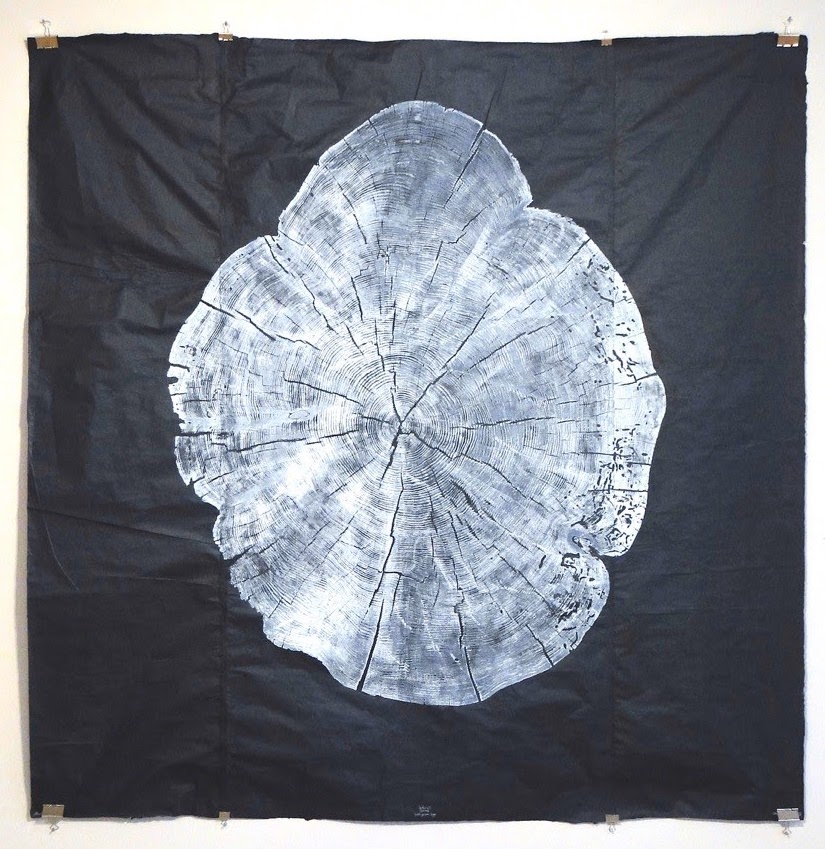Mark Iwinski
Durham, NC
ARTIST STATEMENT
History is replete
with absence. What began as desire to
experience the grandeur of pre-Columbian old growth forests, see razed
buildings stand again, imagined forms materialize and lost frescos adorn walls
and now empty domes has lead me to become an environmental archaeologist, a
virtual rebuilder of walls and muralist.
Lost architecture, artworks and mighty old growth forests all leave traces revealing themselves to us from out of the past. Stumps mark intersections between the forest and history. Ruins, maps and old photographs provide traces of cultural, urban and natural environments while a drawing, print or painted copy may be all that remains of a lost fresco or other artwork. Historical objects, photographs, and memories can evoke a return of the dead reminding us of bygone times and lives. Using these enigmatic forms and sometimes haunting traces enables me to give presence to these terrains of absence.
An essential part of my practice as an artist, my drawings and watercolors give form to these terrains, ideas and histories. They are often starting places for sculptures and artist books. Even observational renderings done when travelling for example; invite me to slow down, linger and observe.
Vested in drawing’s material processes and traditions I often make my own inks and watercolors adding an alchemical quality to the work while using squaring and other old master techniques of transferring and enlarging. My drawings take on a physicality from the use of specific papers with their intrinsic qualities to the marks on a page with brushstrokes in ink and watercolor. My ideas of drawing also incorporate the use of alternative techniques including rubbings or prints taken from an old growth tree stump or the physicality of the cross hatching effect from charred gouges made across the surface of wood with a chainsaw.
Drawing is quintessentially the idea made visible. It insists on presence even as time and absence alter and elide the world around us. My works endeavor to make these absences visually tangible.
Lost architecture, artworks and mighty old growth forests all leave traces revealing themselves to us from out of the past. Stumps mark intersections between the forest and history. Ruins, maps and old photographs provide traces of cultural, urban and natural environments while a drawing, print or painted copy may be all that remains of a lost fresco or other artwork. Historical objects, photographs, and memories can evoke a return of the dead reminding us of bygone times and lives. Using these enigmatic forms and sometimes haunting traces enables me to give presence to these terrains of absence.
An essential part of my practice as an artist, my drawings and watercolors give form to these terrains, ideas and histories. They are often starting places for sculptures and artist books. Even observational renderings done when travelling for example; invite me to slow down, linger and observe.
Vested in drawing’s material processes and traditions I often make my own inks and watercolors adding an alchemical quality to the work while using squaring and other old master techniques of transferring and enlarging. My drawings take on a physicality from the use of specific papers with their intrinsic qualities to the marks on a page with brushstrokes in ink and watercolor. My ideas of drawing also incorporate the use of alternative techniques including rubbings or prints taken from an old growth tree stump or the physicality of the cross hatching effect from charred gouges made across the surface of wood with a chainsaw.
Drawing is quintessentially the idea made visible. It insists on presence even as time and absence alter and elide the world around us. My works endeavor to make these absences visually tangible.
BIO
Mark Iwinski, (b. 1960) is a multimedia visual artist working in Sculpture, Drawing, Book Arts and Printmaking and a form of rephotography. All revealing layers of absence and loss in the memory, history and layered cultural fabric of our landscapes and cities. Originally, from Milwaukee, Wisconsin, he received a BFA,1986 including Study Abroad in Italy, 1987 and an MFA, 1991 in sculpture and drawing from the University of Wisconsin Milwaukee. Exhibiting nationally, his work has entered a range of collections including the Southern Graphics Council International and national and several national and international book arts collections. His work has been recognized through grant awards such as the Constance Saltonstall Foundation Grant in 2006 for works on paper addressing the loss of old growth forests and deforestation with stump prints. Other awards include a New York Foundation for the Arts and North Carolina Arts Council fellowships in 2008 and 2010 respectively, both awarded for his rephotography work revealing losses in the architectural fabric and cultural memory of our cityscapes and environment. He has taught at several universities including the College of William and Mary, Dartmouth College and Cornell University and is currently an adjunct assistant professor at Elon University. Selected recent exhibitions include Print Summit 2010, a national survey, at Eastern Carolina University, Imprints at The Greenhill Center in Greensboro, NC, Logjam at the James Watrous Gallery, Wisconsin Academy of Sciences, Arts and Letters, in Madison, WI and Arbor Incognita, Alcott Gallery, University of North Carolina Chapel Hill.

